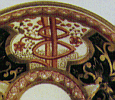Menu

Home Calligraphy Trip to Beijing Focus on Japan Zen Belleza Odiada ConnectedGlobe
To see this page in your own language use the following translation bar.
 One day when I was looking at the background of the Cartouche containing the "Dollar Pattern" of
Spode porcelain, suddenly it started looking like another pattern forming a shape like a
face. Eventually I realised that there is really another independent figurative pattern existing in the
dark blue background. The background or next segmented area to the Cartouche containing the
"Dollar Pattern" is forming an ancient Chinese pattern called taotie (monster) mask.
One day when I was looking at the background of the Cartouche containing the "Dollar Pattern" of
Spode porcelain, suddenly it started looking like another pattern forming a shape like a
face. Eventually I realised that there is really another independent figurative pattern existing in the
dark blue background. The background or next segmented area to the Cartouche containing the
"Dollar Pattern" is forming an ancient Chinese pattern called taotie (monster) mask.
 Taotie is one of the oldest patterns used in Chinese decoration. It was represented in the Shang
Dynasty (1600-1100 B.C.) on bronzes where it was depicted in a very stylised form consisting of
two angular dragons facing each other and placed in such a way as to form a mask. The mystery of this ancient image is very enigmatic and seems almost unexplicable.
However, it is believed that the literal souce of taotie is derived from Chinese mythology and the decoration was applied on ritual bronze vases for evil-averting.
The iconography and the semantic meanings of such an ancient society controlled by divinities might be far from our understanding.
Taotie is one of the oldest patterns used in Chinese decoration. It was represented in the Shang
Dynasty (1600-1100 B.C.) on bronzes where it was depicted in a very stylised form consisting of
two angular dragons facing each other and placed in such a way as to form a mask. The mystery of this ancient image is very enigmatic and seems almost unexplicable.
However, it is believed that the literal souce of taotie is derived from Chinese mythology and the decoration was applied on ritual bronze vases for evil-averting.
The iconography and the semantic meanings of such an ancient society controlled by divinities might be far from our understanding.
 However, the pattern of taotie has been repeated again and again in the long history of decoration.
In Chinese KRAAK porcelains also, there are some examples in which the taotie mask is painted as a
predominant motif on the rim. However, the type of taotie masks depicted on the KRAAK
porcelain do not look like the traditional stylised prototype. The monsters have more friendly
expressions with two large eyes, often embellished with long lashes, and a broad nose.
However, the pattern of taotie has been repeated again and again in the long history of decoration.
In Chinese KRAAK porcelains also, there are some examples in which the taotie mask is painted as a
predominant motif on the rim. However, the type of taotie masks depicted on the KRAAK
porcelain do not look like the traditional stylised prototype. The monsters have more friendly
expressions with two large eyes, often embellished with long lashes, and a broad nose.
Maura Rinaldi has written in her book KRAAK PORCELAIN (p.130) that
" ... It is interesting to note that though referred to as a taotie, the representation on the klapmuts is in fact, most unlike the traditional Chinese monster mask.
Instead it has a definite resemblance to gala, the mythological Indian glutton who was punished by having to eat his own body
until only the mouth and upper part of the head and two tiny hands remained."

© 2019 Graham G Hawker
Privacy Policy